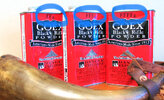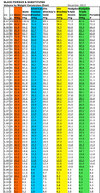I believe the thread started out asking why there are "gaps" in the load data among the 3 divisions of 45-70 categorized data.
I remember that thread... I opined that in generating the 3 'tiers' of data for the .45-70 specifically, not only were they addressing the firearm limits themselves, but also a velocity threshold. Blackpowder-EQ load, for example, suggest a cast bullet at fairly sedate velocity; you would not spec a heavy jacketed bullet for that purpose because of pressure limits, and/or the danger of sticking a jacketed bullet at low velocity. The same powder and same bullet could be ramped up accordingly for 'modern lever-action' loads, and still be a reasonable solution, along with some jacketed bullets. The same powder and a jacketed bullet could be ramped up into Tier 3 loads, very likely with only jacketed bullets... because of the velocity potential... or, perhaps 'hard cast' gas checked cast bullets, too.
I shoot a fair amount of .45-70, these days in a modern 1885, but kept at BP velocity for my own reasons. I also shoot lower velocity cast rifle loads in .30-30, .308, and .348WCF... but with an appropriate powder, using published data.
I'm puzzled when people say not to reduce loads more than 10%,it can be just as dangerous as over- pressure loads. Hodgdon lists max loads for .45/70 lever action rifles 60 gr. of powder under a 300 gr. SJHP, then lists 45 gr. for minimum black powder pressure loads. That is a reduction of 25%. Same case, bullet and powder from the same rifle. What gives?
As was mentioned, don't anticipate anyone giving a blanket statement that it's OK to download any powder/bullet/cartridge combination... there are too many elements and variables in that. As was also mentioned, some powders don't like to be downloaded (H110/W296 come to mind) and is noted as such in published data, just like some powders don't like to be compressed (TrailBoss comes to mind.) Some powders are more versatile in that arena... thinking of cast bullets in rifle, IMR4198, IMR4227, 2400, and some others really excel at that, others not so much. It boils down to the right tool for the job...
For example, I would not reduce a charge of a slower powder, like H4350 or H4831, in an attempt to generate a 'low velocity' or reduced load... that is a poor choice of powder to do the job, when an ideal powder, like IMR4198, or even IMR3031, would handle that with no danger.




